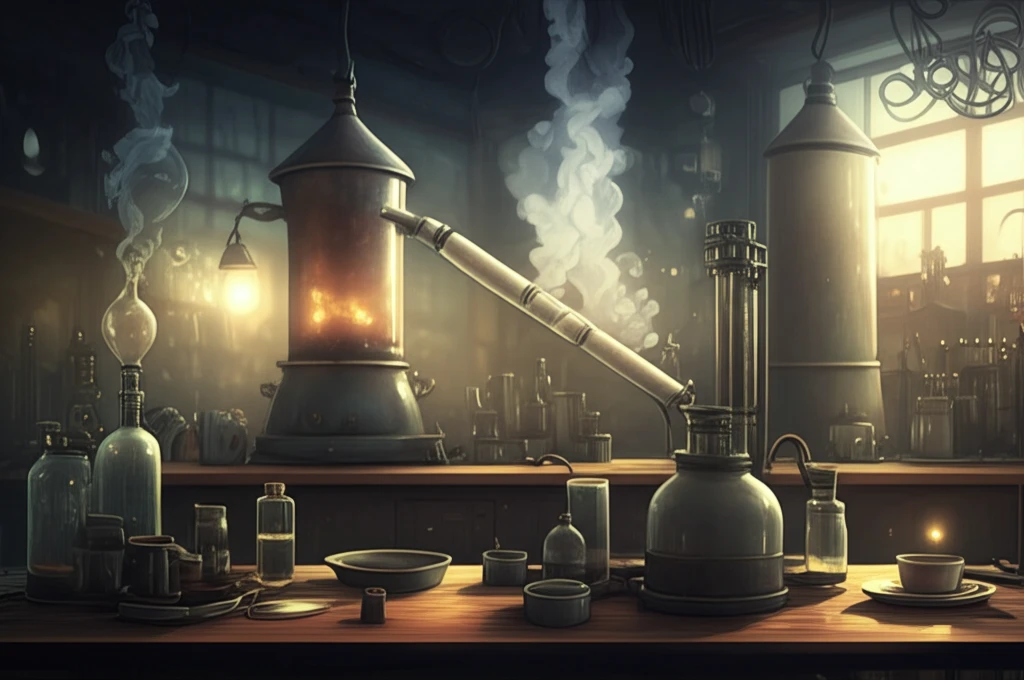
Unlocking Purity: The Complete Guide to Distillation at Home
"From essential oils to homemade spirits, master the art of distillation and discover its surprising applications."
Distillation is a widely used technique in chemical analysis for characterizing materials by establishing an index of purity and for separating selected components from a complete matrix. The technique is even more widely used in preparative chemistry and throughout manufacturing industry as a means of purifying products and chemical intermediates. Distillation operations differ enormously in size and complexity from the semimicro scale to the "thousands of tons per annum" production operations. For analytical purposes the scale employed is usually bench-level.
Numerous quoted standard specifications refer to distillation ranges as criteria of purity or suitability for use, or as indicators of performance. Published standards for analytical reagents in the AnalaR range and similar documentation by the American Chemical Society refer to distillation ranges as criteria of purity for appropriate materials.
Distillation is the process that occurs when a liquid sample is volatilized to produce a vapor that is subsequently condensed to a liquid richer in the more volatile components of the original sample. The volatilization process usually involves heating the liquid but it may also be achieved by reducing the pressure or by a combination of both. This can be demonstrated in a simple laboratory distillation apparatus comprising a flask, distillation head, condenser, and sample collector (Fig. 1). A thermometer is included in the apparatus as shown to monitor the progress of the operation. In its simplest form this procedure results in a separation into a volatile fraction collected in the receiver flask and a nonvolatile residue in the distillation flask. When a distillation column is incorporated in the equipment (Fig. 2), the evaporation and condensation processes occur continuously. This results in a progressive fractionation of the volatiles as they pass up the column. The most volatile components emerge from the top of the column initially and the less volatile components emerge later. By changing the receivers throughout the course of the distillation a separation or fractionation is effected. Eventually, all the volatiles will have passed over into the sample collectors and any involatile residue present will remain in the distillation flask.
The Science Behind the Separation: How Does Distillation Work?

The magic of distillation lies in exploiting the different boiling points of liquids. Imagine a mixture of water and alcohol. Alcohol has a lower boiling point than water, meaning it turns into vapor at a lower temperature. By carefully heating the mixture, you can vaporize the alcohol while leaving most of the water behind. This vapor is then cooled and condensed back into a liquid, resulting in a more concentrated alcohol solution.
- Vaporization: The liquid mixture is heated, causing the component with the lower boiling point to turn into vapor.
- Separation: The vapor travels upwards, leaving behind the liquid with the higher boiling point.
- Condensation: The vapor is cooled, causing it to condense back into a liquid.
- Collection: The condensed liquid, now enriched in the more volatile component, is collected separately.
Distillation: A Gateway to Creative Exploration
Whether you're driven by scientific curiosity, a desire for natural products, or the allure of crafting your own spirits, distillation offers a rewarding journey of discovery. By understanding the principles and mastering the techniques, you can unlock a world of possibilities and create products that are both pure and uniquely your own.
